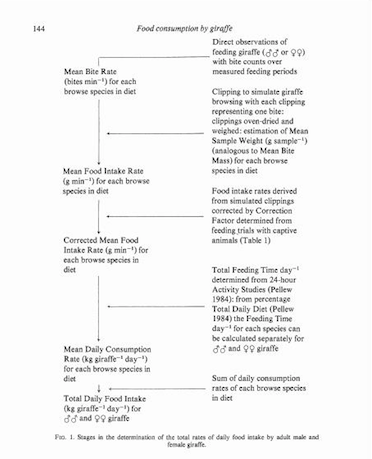Calculating How Much Browse a Giraffe Eats
Calculating How Much Browse a Giraffe Eats
Author: Dr Lauren Samet, EAZA European Nutrition Group's Co-Chair and Zoo Nutrition Consultant
And not just giraffes, it could be okapis, black rhinos, gorillas; the list goes on and on. Keeping track of an animal’s diet, even the more ad lib parts of it, is important to ensure accurate nutritional records, but also to ensure natural activity budgets in captivity, which is an important factor for good welfare. Tracking diets can also help estimate costs associated with captive feeding, can help prepare for seasonal changes, help calculate digestibility efficiency, assess dietary changes required if group size or structure changes, assist interpretation of activity budgets or behavioural observations, and be valuable information if required for health or veterinary records.
Here we summarise a few of the methods for calculating browse intake, and to ask readers how you might calculate this magic number at your collection? So please comment and share your favourite reference papers, ideas, methods and “life hacks” below.
The Scientific Example
One example of working out the answer to the title question comes from Pellew’s (1984) paper (which can be read in full online here). The paper details the level of work, commitment and calculations it can involve. It’s an “oldy”, but a goody as they say. At the time of writing it had been cited 107 times, a good number for this niche field. In the paper Pellew estimates the efficiency of giraffe foraging strategy by first assessing the rate of food intake by adult giraffe, which is summarised in the figure below.

Figure. Stages in the determination of the total rates of daily food intake by adult male and female giraffe (from Pellew, 1984).
The advantage of Pellew’s paper is that the animals are demonstrating wild behaviours in situ, with natural access to wild browse species. This diet is the gold standard in terms of what we would be trying to recreate in captivity. Unfortunately, the same conditions are rarely available in captivity. In the wild giraffe show a lot of selective foraging behaviours, which they may not have the luxury of in captivity. Therefore, the nutrient values/amounts eaten etc are likely to differ, raising the question of whether this data is applicable to captive individuals.
Imagine trying to recreate this study during day to day life in a zoo! The time it would take to set up, monitor, record data (and for a 24-hour period too! - let’s just take a moment to appreciate the logistics of that - accurately observing an animal overnight requires lots of coffee and excellent eyesight in the dark - use a light or a torch and you are at risk of changing the animals’ behaviours). It can be painstaking work (e.g. counting bites!) but it is worth it because good solid science like this helps lay the foundations for the future nuances, updates and improvements in the exploration of animal nutrition and appropriate captive diets for species that in the future may need to live and breed in captivity to support their species’ survival in the wild.
Examples like this are everywhere in the field of animal nutrition but there is lots more work to do. We just about have a handle on the number of species on the planet, let alone what each one eats in the wild! Going back to basics: observing, collecting and measuring the simplest of diets is what designing appropriate captive diets is built on - and let’s not forget that diets can also be seasonal so the whole process could and should ideally be repeated for each season of the year.
The Practical Example
So what methods are more possible in captivity? One example if animals have browse-free enclosures, is to weigh browse and record this before adding it to the enclosure. Ideally after a 24 hour period the remnants of remaining browse/branches are removed, weighed again, recorded, then the difference calculated to see what has been consumed.
This is probably the next best thing to the scientific example and achievable in captivity, however ideally all giraffe enclosures would support some access to natural browse in their design (not only does this cut down work for keepers in having to supply giraffe with browse, it also allows the giraffe access to natural foraging and feeding behaviours at any time of the day regardless of additional browse provision). However, this means that without the measures taken in the Pellew (1984) example it is difficult to know how much of this natural browse provision is consumed every day.
Additionally, weighing browse is easier said than done! It is heavy work and unless you are fortunate enough to have access to scales / weighing equipment close to the giraffe house, it may not be possible to be a part of your regular routine.
This practical example takes some organisation and some time out of busy keeper schedules. It also requires the whole team to invest in it if it is to collect accurate data. Obviously, a key point in this method is recording the browse weights, which sounds simple but chances are that the easiest, most affordable way to do this is in a paper log book, which may or may not go missing / be dropped in a water bucket. Therefore, the weights recorded need backing up regularly to a spreadsheet or some form of electronic back up system to hopefully avoid the tragedy that is data loss (you may think it won’t happen to you, but it happens. To everyone. Yes, it has happened to me). Illegible handwriting can also be an issue when it is cold and you cannot feel your hands and/or you’re in a rush. Translating your written data on the day can assist this.
Although it sounds like I have listed a lot of cons for this method, it is possible, and if done well it can provide the information you need. A few extra points to note on this method are: 1. It’s really hard to provide browse in the amounts needed for ad lib access in captivity, therefore, your results may not necessarily show what a giraffe would ideally consume but just what they are able to consume from what’s provided. 2. Giraffe are commonly kept in groups in captivity so while results may just be divided by the group number to provide an average for what one giraffe in the group may consume, it is possible values of intake range widely between individuals - remember not to take this for granted when making dietary calculations.
The Most Likely Example
But who has scales just for weighing browse, or time!? If you’ve never thought about measuring the amount of browse you feed, fear not – it is well known that we are mostly much more obsessed with thinking about how we can provide more browse on any given day because everything we provide is always cleared! (NB. the 2006 EAZA Management & Husbandry Guidelines for Giraffa camelopardalis guidelines recommend 60 to 70 % of forage in captive giraffe diets (Lintzenich & Ward, 1997) but simultaneously note it is a “completely unrealistic scenario” to be able to provide adequate amounts for a 100% forage based diet).
If it has never crossed your mind to quantify how much your collection feeds, it is never too late to calculate it. If time and resources are limited it may be preferable for you to carry out a short one to two-week monitoring project (ideally in each season) to gauge the average amounts you feed instead. Record the species of plant fed, the amounts, palatability, time of year, and any other factors which you think may affect consumption. Keep it saved electronically on file (and make a backup!), then even if you do not use or need the data for a while, you have it ready for when the nutritionist comes calling or you are asked to justify your ideal feeding budget.
In Summary
These are just a few examples of how to calculate a browsing animal’s browse provision/intake but variations and other ideas exist (please do add yours in the comments section below and share your methods alongside its pros and cons). Hopefully, they have helped build a case for how and why it is useful to record browse provision, even if just for a few weeks per year. For a few more examples of when and how calculations have been useful see “Further Reading” in the reference list below.
References
EAZA (2006) EAZA Husbandry and Management Guidelines for Giraffa Camelopardalis [Online]. Available at: https://www.girafferesourcecentre.org/wpdm-package/eaza-husbandry-and-management-guidelines-giraffa-camelopardalis-2006/?fbclid=IwAR3wrPlX01e2igmmtd6BqBxpOh5cR1t79lI-EX8SY2iag9XaUTWPPNIg6Fk (accessed 20.08.2020)
Pellew, R. A. (1984) Food Consumption and Energy Budgets of the Giraffe. Journal of Applied Ecology 21 (1) pp. 141-159)
Further Reading
Clauss, M., Castell, J. C., Kienzle, E., Dierenfeld, E. S., Flach, E. J., Behlert, O., ... & Hatt, J. M. (2006). Digestion coefficients achieved by the black rhinoceros (Diceros bicornis), a large browsing hindgut fermenter. Journal of Animal Physiology and Animal Nutrition, 90(7‐8), 325-334.
Clauss, M., Wilkins, T., Hartley, A., & Hatt, J. M. (2009). Diet composition, food intake, body condition, and fecal consistency in captive tapirs (Tapirus spp.) in UK collections. Zoo Biology: Published in affiliation with the American Zoo and Aquarium Association, 28(4), 279-291.
Hatt, J. M., Schaub, D., Wanner, M., Wettstein, H. R., Flach, E. J., Tack, C. & Clauss, M. (2005). Energy and fibre intake in a group of captive giraffe (Giraffa camelopardalis) offered increasing amounts of browse. Journal of Veterinary Medicine Series A, 52(10), 485-490.
Gussek, Isabel Ruth: Nutrition of giraffes (Giraffa camelopardalis) in captivity: Evaluation of feeding practice and analysis of rations in European zoos. - Bonn, 2016. - Dissertation, Rheinische Friedrich-Wilhelms-Universität Bonn. Online-Ausgabe in bonndoc: https://nbn-resolving.org/urn:nbn:de:hbz:5n-43725
Pellew, R. A. (1984). The feeding ecology of a selective browser, the giraffe (Giraffa camelopardalis tippelskirchi). Journal of Zoology, 202(1), 57-81.



